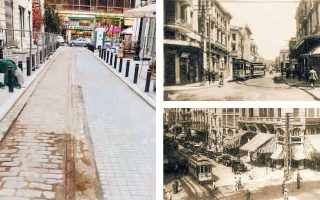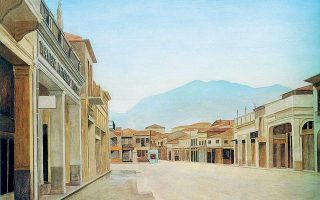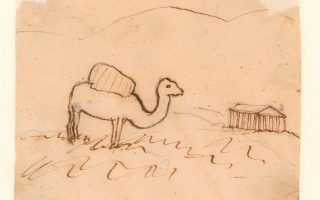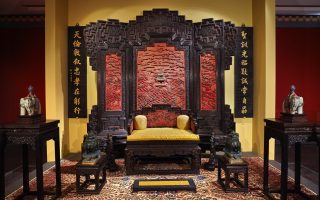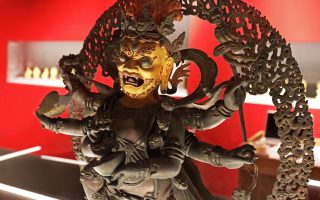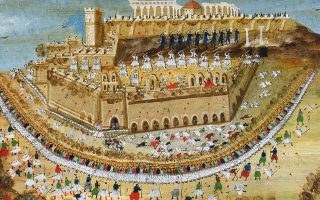A glimpse into the private life of Princess Sisi
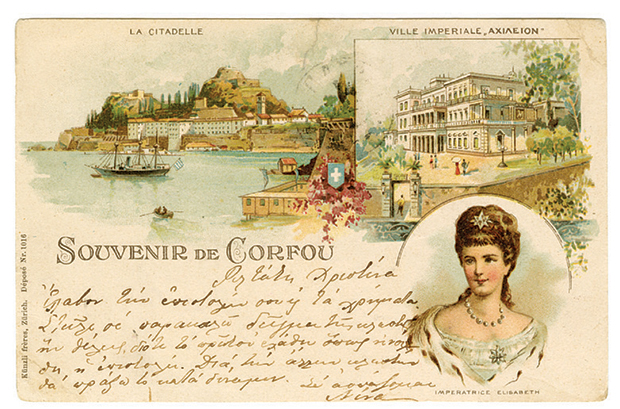
The estate that so enchanted Empress Elisabeth of Austria (1837-98) when she first visited the verdant Ionian island of Corfu is one of the subjects of an exhibition that was recently inaugurated at its Museum of Asian Art.
The deed of purchase of the estate, known at the time as Villa Vraila, is among its fascinating displays. It was found in the local records office and reveals how the empress – who was known by the nickname Sisi – purchased the property from the distinguished Corfiot diplomat and poet Petros Vrailas Armenis (1814-64). She went on to demolish the original house that stood on the estate and build the Achilleion Palace.
A pair of elegant gloves gifted to the Austrian empress by a local family, two porcelain vases, pages from her diary, poems, newspapers of the time, photographs and postcards are also included among the displays of this small exhibition, which will remain at the Palace of Saint Michael and Saint George at the northern end of the Esplanade in Corfu Town through November 5.
Elisabeth, who became queen of Hungary after marrying Emperor Franz Joseph I of the House of Habsburg, visited the Greek island on multiple occasions, archaeologist and museum director Despina Zernioti told Kathimerini.
Zernioti also curated the show, along with the museum’s head of exhibitions, Stamatis Hondroyiannis, with the aim of casting light on this fascinating woman and ardent philhellene.
“Even during her lifetime, the empress’ real life was colored by legend and idealization. Growing up in Munich, she had been strongly exposed to the philhellenist movement, as this was a time when travelers had provided images of Greece. Her love for our country is not just due to her Greek teachers, but also to her family ties, as Otto, the first king of Greece, was her cousin,” says Zernioti.
Elisabeth had several Greek teachers, the most famous among which was Konstantinos Christomanos, who taught her about the country’s ancient history. Some of them fell in love with the spirited empress and wrote poems about her. Among them was Konstantinos Manos, whose poems are displayed in the exhibition.
“Everything conspired toward her picking Corfu as her sanctuary. She fell in love with the island the moment her private yacht dropped anchor here in 1861. She wrote a lot of poems about Corfu, which she would reminisce on from her first visit, which lasted at least four months. Gastouri, where she rode and took walks, was the first area she became acquainted with. The island was under British rule at the time, and the empress was often invited to the palace by the high commissioner, right here where the Museum of Asian Art is today,” the curator says. “The Corfiots also loved her.”
The Achilleion was built between 1887 and 1891 in a grandiose style that belied its owner’s low-key ways. Sisi’s diaries reveal that she enjoyed life there, spending her days like a “regular” person and reliving her childhood.
“She didn’t enjoy the pompous ceremonies and strict etiquette of court life. In one poem after her marriage to Franz Joseph, in fact, she likened it to waking up in a dungeon with chains around her hands, without liberty,” says Zernioti.
In another entry, she describes her marriage as the “start” of all her troubles. “Her apparent happiness hid untold misery,” she adds.
Sisi was just 16 when she got married and not long after she began suffering from various health problems and showing signs of depression. Franz Joseph’s imperious mother Princess Sophie of Bavaria was also a very controlling mother-in-law, particularly on the issue of her grandchildren’s upbringing. The rift between the two women only widened with the death of Sisi’s first child, Sophie, in infancy.
“The tragedy at Mayerling in 1889 with the death of her only son was the final blow. Sisi returned to Corfu in a terrible state of health. They said she had tuberculosis but it is unlikely that her doctor would have allowed her to travel to a place with so much humidity if that were the case. As she wrote in her journals, Corfu became her sanctuary,” says Zernioti.
Rudolf and his lover Baroness Mary Vetsera were found dead at the imperial hunting lodge in Mayerling in an apparent murder-suicide some say was prompted by political difference and others by the lovers’ discovery that they were in fact half-siblings.
After spending some time in Corfu recovering, Sisi started traveling extensively and visitors to the exhibition will learn about the aftermath of her assassination by an Italian anarchist in Geneva in 1898.
The palace’s emblem, meanwhile, depicts a dolphin inspired by the myth of Hermias at Iasos in Caria, wearing the Austrian imperial crown.
“The myth is about the friendship that grew between a boy and a dolphin who played and swan together until one day, the boy drowned in a storm. The dolphin carried the boy to the coast and stayed by his side until it, too, died. The myth has been associated with the Austrian empress’ death and to her life in this house after the demise of Sophie and later her son,” says Zernioti.
Sisi left the Achilleion to her daughter Gisela but the archduchess did not want it so it was closed until it caught the admiring eye of German Kaiser Wilhelm II in 1905.
Following the 1924 abolition of the monarchy in Greece, the Achilleion and all of its contents were put up for auction. “We found the auction pamphlet with the prices at which everything was sold from a private collector,” Zernioti says.
Now the property of the Greek National Tourism Organization, the Achilleion is one of Corfu’s most popular tourist attractions, generating around 4 million euros a year in admissions fees, says the director of the Museum of Asian Art, which is a part of the palace complex.
